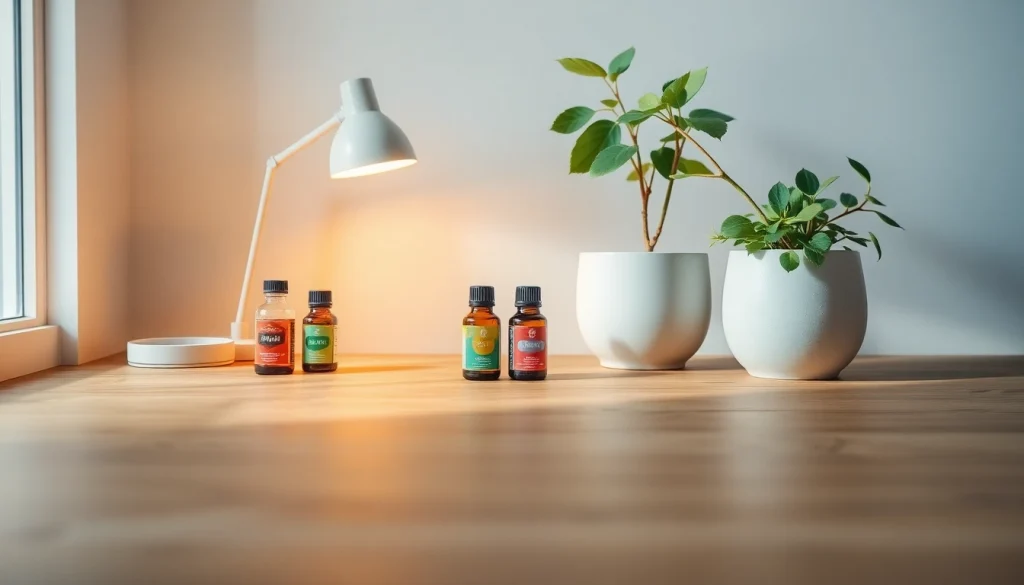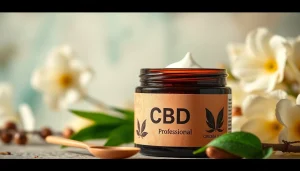Understanding Essential Oils
What are Essential Oils?
Essential oils are concentrated, volatile aromatic compounds extracted from plants. These oils capture the plant’s natural fragrance and exhibit numerous beneficial properties. Used for various purposes—from aromatherapy to skincare—essential oils are gaining popularity for their holistic health benefits. Unlike synthetic fragrances, which often contain harmful chemicals, natural essential oils offer a range of therapeutic effects. Many people find that using essential oil enhances their well-being and supports overall health.
How Essential Oils are Extracted
The extraction of essential oils can be done through several methods, each affecting the oil’s quality and properties. The most common methods include:
- Steam Distillation: This is the most prevalent method, whereby steam passes through the plant material, causing the oil to evaporate. The vapor is then condensed back into liquid, separating the oil from the water.
- Cold Pressing: Primarily used for citrus fruits, this method involves mechanically pressing the peels to release the essential oils.
- Solvent Extraction: In this technique, solvents are used to dissolve the aromatic compounds. The mixture is later refined to remove the solvent, yielding a fragrant oil.
- CO2 Extraction: This modern technique uses carbon dioxide under high pressure and low temperature to draw out essential oils while preserving their full aromatic profile.
Each of these extraction methods can yield oils of varying quality, making the choice of extraction method an important factor in the effectiveness of the essential oils.
The History of Essential Oils in Wellness
The use of essential oils dates back thousands of years. Ancient civilizations, including the Egyptians, Greeks, and Chinese, utilized plant extracts for both medicinal and cosmetic purposes. The Egyptians incorporated essential oils into their religious rituals, while the Greeks recognized the therapeutic benefits and began experimenting with them in various forms.
The modern movement toward the use of essential oils for wellness began in the early 20th century, thanks to the work of French chemist René-Maurice Gattefossé, who coined the term “aromatherapy.” His study of lavender oil’s healing properties after a laboratory explosion set the stage for systemic research into the field. Today, essential oils are frequently adopted in holistic health practices, emphasizing their rich history intertwined with human wellness.
The Benefits of Essential Oils for Health
Essential Oil Properties That Promote Healing
Essential oils harness a unique set of therapeutic properties due to their chemical compounds. Common properties of essential oils include:
- Antimicrobial: Many essential oils like tea tree and eucalyptus possess properties that can combat bacteria and fungi, promoting wound healing and infection prevention.
- Anti-inflammatory: Oils such as chamomile and lavender are known for their calming effects, helping to reduce inflammation and pain.
- Antioxidant: Oils like rosemary and clove contain antioxidants that help defend cells against oxidative stress and promote overall health.
These properties contribute to various uses of essential oils in promoting health, from treating minor ailments to enhancing well-being.
Using Essential Oils for Stress Relief
In today’s fast-paced world, stress has become a common issue impacting mental health. Essential oils, particularly those with calming scents, play a vital role in reducing stress and anxiety. Oils such as lavender, bergamot, and ylang-ylang have been shown to lower cortisol levels and promote relaxation.
Incorporating essential oils into daily routines can be achieved through methods such as:
- Aromatherapy Diffusion: Using a diffuser to disperse essential oils into the air creates a calming atmosphere.
- Topical Application: Diluting essential oils with a carrier oil and applying them to pulse points can provide localized stress relief.
- Bathing: Adding a few drops of essential oil to bathwater can amplify relaxation during a soak.
This holistic approach supports mental well-being and offers tangible stress relief benefits.
Boosting Your Immune System with Essential Oils
Essential oils can significantly enhance the immune system, providing a natural defense against illness. Oils such as eucalyptus, oregano, and tea tree oil possess immune-boosting properties and are often used to support the body during flu seasons or outbreaks.
Regular use of these oils can be achieved in several effective ways:
- Inhalation: Inhaling essential oils through a diffuser or steam inhalation can facilitate respiratory health and open airways.
- Massage: Diluting essential oils in carrier oils and massaging the blend into the lymphatic points promotes circulation and detoxification.
- Bath Soaks: Combining immune-boosting oils in bath soaks allows the body to absorb their benefits through the skin while enjoying a therapeutic experience.
Integrating these practices not only promotes physical health but also enhances the overall quality of life.
Practical Uses of Essential Oils
Essential Oils in Aromatherapy
Aromatherapy, the practice of using essential oils to enhance physical and psychological well-being, is perhaps the most famous application of essential oils. It involves the targeted use of various oils based on their therapeutic properties to address specific health issues.
Some popular essential oils in aromatherapy include:
- Lavender: Known for its calming properties, it is often used to alleviate insomnia and stress.
- Peppermint: Used for its energizing effects, it can help clear the mind and alleviate headaches.
- Frankincense: Revered for its grounding properties, it can help with meditation and enhancing spiritual practices.
By creating personalized aromatherapy routines, individuals can address their needs and promote a sense of well-being through everyday practices.
Creating DIY Essential Oil Blends
Creating personalized essential oil blends allows individuals to tailor their aromatherapy experiences. Blending oils is a straightforward process that requires understanding the properties of each oil and how they complement one another. To create an effective blend, consider the following:
- Base Notes: These are typically heavier scents, such as sandalwood or cedarwood, and help to anchor the blend.
- Middle Notes: These oils provide balance and often include floral or herbal scents like lavender or rosemary.
- Top Notes: The most volatile and lightest scents, such as citrus oils, add freshness to the blend.
A general guideline is to use about 30% base notes, 50% middle notes, and 20% top notes for a harmonious blend. Always conduct a patch test to ensure skin compatibility and address any sensitivities.
Incorporating Essential Oils in Daily Routines
Integrating essential oils into everyday life provides a variety of ways to enhance both physical and emotional well-being. Here are practical tips for implementing essential oils into daily routines:
- Morning Rituals: Add lemon or peppermint essential oils to your morning water or diffusing them as you wake up can invigorate your senses and energize your day.
- During Work: Diffusing essential oils like rosemary can improve concentration and memory in a workplace setting.
- Evening Wind Down: A bedtime routine incorporating calming scents like lavender can aid relaxation and improve sleep quality.
By thoughtfully applying essential oils throughout the day, you can create refreshing experiences that elevate your overall quality of life.
Choosing Quality Essential Oils
What to Look for in Essential Oil Labels
When selecting essential oils, it’s vital to understand how to identify quality products. Labels can provide essential information that indicates purity and authenticity, including:
- Botanical Name: The scientific name of the plant ensures you are getting the specific oil you desire.
- 100% Pure: Look for labels stating the oils are undiluted and free from fillers.
- Country of Origin: This shows where the plant was harvested, as terroir can affect the oil’s properties.
- Extraction Method: Information about how the oil was extracted is significant in assessing its quality.
By paying attention to these details, consumers can avoid synthetic or adulterated oils and choose only the best for their health and wellness.
Top Brands for Pure Essential Oils
Choosing reputable brands is crucial to ensure the quality of your essential oils. Some top brands known for their commitment to purity and sustainability include:
- Young Living: Pioneers in the essential oil industry, known for their seed-to-seal commitment.
- doTERRA: Recognized for their rigorous testing and sourcing quality oils from around the world.
- Plant Therapy: Offers a wide variety of essential oils at affordable prices, along with kid-safe options.
Investigating these brands and their sourcing practices can lead you to high-quality essential oils that align with your health goals.
How to Store Essential Oils Safely
Storing essential oils properly is critical for maintaining their effectiveness and longevity. Here are some essential guidelines to consider:
- Keep Out of Direct Sunlight: Light can degrade essential oils, so it’s best to store them in dark glass bottles away from light sources.
- Avoid Heat: Store oils in a cool, temperature-stable environment, as excessive heat can alter their chemistry.
- Proper Sealing: Ensure lids are tightly sealed after use to prevent oxidation.
Following these storage practices will help you preserve the integrity of your essential oils for longer periods, allowing you to enjoy their benefits.
Essential Oil Safety and Precautions
Common Essential Oil Mistakes to Avoid
While essential oils offer numerous benefits, improper use can lead to adverse reactions. Common mistakes to avoid include:
- Using Undiluted Oils: Essential oils are potent and should always be diluted with carrier oils before topical application to prevent skin irritation.
- Using Oils Near Mucous Membranes: Oils should be kept away from the eyes, ears, and mucous membranes unless specifically formulated for those areas.
- Ignoring Allergies: Always check for potential allergies before using new essential oils. Conduct a patch test on a small skin area.
Being mindful of these common pitfalls will enhance safety when using essential oils.
Allergies and Sensitivities to Essential Oils
Some individuals may experience allergies or sensitivities to certain essential oils, and it’s essential to recognize potential symptoms, which can include:
- Skin irritation, redness, or rashes following topical application.
- Respiratory issues upon inhalation, such as coughing or wheezing.
- Headaches or nausea after diffusing or inhaling certain scents.
If reactions are suspected, cease use immediately and consult a healthcare professional for guidance.
Guidelines for Use with Children and Pets
When incorporating essential oils into households with children and pets, special precautions are necessary:
- Children: Use oils specifically designed for children, and consult a pediatrician for guidance on suitable oils and methods of application.
- Pets: Some oils can be toxic to pets. Always research pet-safe oils and consult your veterinarian before usage.
By adhering to these guidelines, you can enjoy the benefits of essential oils while ensuring the safety of your loved ones.








